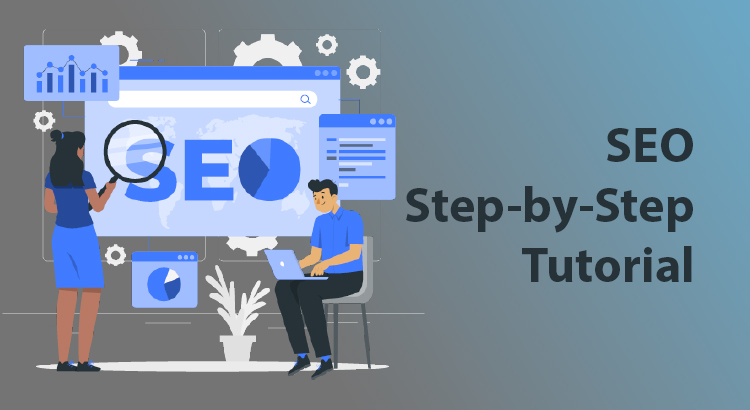This SEO step-by-step guide for beginners is designed to simplify the process of improving online visibility. Search engine optimization involves a mix of technical and creative elements that help websites attract more attention from search engines. Whether you’re building a new site or improving an existing one, understanding the core methods is essential. This guide breaks down the essentials into practical, easy-to-follow parts.
SEO Basics
Understanding SEO basics is essential for anyone looking to improve online visibility. Let’s look at a few foundational terms related to website optimization:
- Search Engine Optimization (SEO): A collection of methods used to enhance a website so it delivers valuable content and ranks well in search results for relevant queries.
- On-page SEO: Improvements made directly on your site, such as refining content keywords or improving technical elements like structure and navigation.
- Off-page SEO: External efforts to boost your website’s authority, including link signals and mentions from reputable sources.
- Link building: Acquiring links from trusted websites to improve credibility and trustworthiness in the eyes of search engines.
- SERPs: The results pages displayed after someone enters a query in a search engine like Google. These pages include both paid and unpaid listings.
- White-hat SEO: Ethical website ranking practices that follow established quality guidelines and focus on long-term success.
- Black-hat SEO: Risky and manipulative actions that exploit algorithm loopholes to increase search rankings. These are often discouraged and can lead to penalties.
- E-E-A-T: Refers to experience, expertise, authoritativeness, and trustworthiness. These principles help search engines evaluate the quality and relevance of content.
- Keyword: The specific words or phrases users enter to find information online. Selecting the right ones helps align your content with what people are searching for.
- Keyword research: The process of identifying commonly used queries related to your niche. This helps guide the language and focus of your site content.
- Organic/organic results: Listings that appear naturally in search results based on relevance, without the influence of paid advertising.
- Organic traffic: Visitors who arrive at your website through unpaid search listings.
- Rank/page ranking: The position your web pages hold in search results for particular queries.
- Ranking factor: Any element that affects your site’s placement in search listings, such as loading speed, authority, or content quality.
- Search intent: The goal behind a user’s query. Understanding this helps tailor content to match what users are hoping to find.
How to Learn SEO?
Learning SEO requires patience and ongoing effort, as the field is constantly adapting to search engine updates. Here are several ways to build your knowledge and stay current:
1. Read and watch reliable resources
There are plenty of trusted blogs, videos, and documentation to help you learn how to improve site performance. Since Google holds over 90% of the global search market, start by exploring its Search Central Blog and the Search Quality Rater Guidelines for foundational knowledge.
2. Take free courses
Structured learning can offer a guided way to understand how to boost online visibility. Many learning platforms also provide certifications. A few recommended courses include:
- HubSpot Academy Website Optimization Training (free): Great for beginners
- Google Analytics Academy (free): Offers both beginner and advanced learning paths
- MOZ Academy (paid): Covers multiple experience levels
- Semrush Academy (free): Offers courses for various levels of expertise
3. Stay on top of the trends
With AI-driven search on the rise, optimization techniques can change rapidly. For example, in late 2022, Google updated its guidelines by adding Experience to the E-A-T framework, emphasizing helpful content created by individuals with subject matter knowledge.
Keeping up with these shifts is crucial. Follow SEO-related blogs and check Google’s updates regularly to adjust your site ranking methods effectively.
4. Study your competitors
Reviewing competitor websites is a smart way to identify what works. Examine where they earn backlinks, what topics they cover, and how their content flows. Try to understand the full content journey they offer and apply those insights to your own strategy.
5. Learn by doing
Practical application is one of the most effective ways to gain skills. If you have an existing website, test out improvements based on your research.
If you’re starting from scratch, build a simple site and practice improving visibility through consistent updates and analysis. Use curiosity and strategic thinking to guide your progress.
6. Use optimization tools
Manual work can be time-consuming, but SEO tools make improving your website much more manageable. Some recommended options include:
- HubSpot’s Optimization Software: Offers improvement suggestions and content analysis
- AI Search Grader: Evaluates your visibility in AI search engines
- Website Grader: Reviews mobile friendliness and overall performance
- Google Search Console: Helps track traffic and address visibility issues
- Google Analytics: Offers traffic insights, including organic vs non-organic visits
- Ahrefs: Useful for keyword discovery and performance tracking
- Jasper: An AI writing tool for crafting content aligned with target queries
Once you’re comfortable with the basics, it’s time to move into hands-on improvement. This guide will soon take you through content, technical, and promotional elements to build a solid foundation for site growth.
SEO Step-by-Step Tutorial
This step-by-step guide walks you through the three main pillars of search engine optimization: on-page optimization, off-page optimization, and technical optimization. Each section breaks down essential actions you can take, with detailed explanations to help you implement them confidently.
On-Page Optimization
On-page strategies focus on improving the content and structure of your pages to make them more relevant and easier for search engines to interpret.
1. Choose the Right Keywords
Use tools like Google Keyword Planner, Ahrefs, or Ubersuggest to find terms that your target audience is searching for. Focus on search intent (what the user wants), monthly search volume, and competition level. Identify both primary and secondary keywords to cover the topic comprehensively.
2. Write High-Quality, User-Focused Content
Once you’ve chosen your keywords, build content that answers real user needs. Avoid shallow, keyword-stuffed content. Instead:
- Address common questions clearly and thoroughly.
- Use examples, bullet points, visuals, and analogies to simplify complex topics.
- Keep paragraphs short and the language natural.
- Incorporate your target keywords naturally without forcing them.
SEO-friendly content not only ranks but also builds trust and keeps readers engaged.
3. Optimize Title Tags and Meta Descriptions
The title tag appears as the clickable headline in search results. Include your main keyword near the beginning and make it compelling. Meta descriptions give users a summary of the page — make them concise (under 160 characters), informative, and include a keyword to boost relevance and click-through rates.
4. Use Header Tags Effectively (H1–H6)
Structure your content using heading tags. Use one H1 per page (usually the title), and organize sections with H2 and H3 tags. This improves readability for users and helps search engines understand the hierarchy of your content.
5. Add Internal Links
Internal links help both users and search engines discover related content on your site. For best results:
- Link to relevant pages using descriptive anchor text (not “click here”).
- Ensure the linked pages are high-quality and informative.
- Use internal links to support the structure of your site and distribute ranking power (link equity).
This improves your site’s crawlability, keeps users on your site longer, and boosts underperforming pages.
6. Optimize Images for Search
Images can improve readability and SEO when optimized properly. Here’s how:
- File names: Use descriptive, keyword-rich names (e.g., chocolate-cake-recipe.jpg).
- Alt text: Add a short, accurate description of the image for screen readers and search engines.
- Compression: Reduce file sizes to improve page load speed without sacrificing quality. Use tools like TinyPNG or ImageOptim.
- Formats: Use modern formats like WebP or AVIF for faster loading.
Well-optimized visuals enhance the user experience and help your content appear in Google Image Search.
7. Use SEO-Friendly URLs
Create short, readable URLs that include your target keyword. Avoid unnecessary numbers, special characters, or stop words (like “and,” “the”). A clean URL structure improves both usability and visibility in search results.
Off-Page Optimization
Off-page methods focus on improving your site’s reputation and authority through external signals and relationships.
1. Earn High-Quality Backlinks
Backlinks are links from other websites pointing to yours. Search engines treat them as votes of confidence, especially when they come from authoritative and relevant sources.
How to earn them:
- Create valuable, link-worthy content like in-depth guides, original research, or infographics.
- Guest post on reputable industry blogs or publications.
- Reach out to site owners and offer helpful content they can reference.
- Use tools like Ahrefs or Semrush to identify your competitors’ backlinks and seek similar opportunities.
Avoid spammy or paid links from low-quality sites, as they can hurt rather than help.
2. Share and Promote Your Content
Use social media, email newsletters, and community platforms like Reddit or Quora to distribute your content. While social shares don’t directly influence rankings, they increase exposure and the likelihood of earning backlinks.
3. Submit Your Site to Online Directories
Getting listed on trusted directories (like Google Business Profile, Yelp, or niche-specific directories) helps search engines validate your business’s authenticity. It also improves your visibility in local and industry-specific searches.
4. Monitor and Encourage Brand Mentions
Mentions without links can still build authority. Track brand mentions using tools like Google Alerts or Mention. Reach out to request a link when appropriate, and ask happy customers or readers to mention your content on their sites or platforms.
Technical Optimization
Technical optimization techniques help search engines efficiently access, crawl, and index your site — the foundation of your optimization efforts.
1. Make Your Site Mobile-Friendly
More than half of global web traffic comes from mobile devices. Use responsive design that adjusts content layout to fit any screen. Tools like Google’s Mobile-Friendly Test can help you identify and fix issues that affect usability on smartphones or tablets.
2. Improve Page Load Speed
Faster sites lead to better user experience and higher rankings. Compress images, use caching, minify code (HTML, CSS, JavaScript), and consider using a Content Delivery Network (CDN). Page speed tools like GTmetrix and Google PageSpeed Insights can guide improvements.
3. Fix Broken Links and Redirects
Dead links frustrate users and block crawlers. Use tools like Screaming Frog or Ahrefs to find 404 errors and redirect them properly. Implement 301 redirects for permanently removed content, and avoid unnecessary redirect chains.
4. Submit an XML Sitemap
An XML sitemap lists all your important pages and helps search engines discover and index them. Generate a sitemap using tools like Yoast or Screaming Frog, and submit it through Google Search Console and Bing Webmaster Tools.
5. Enable HTTPS (SSL Certificate)
Security is a ranking factor. Sites using HTTPS instead of HTTP get a small ranking boost and more user trust. Most hosting providers offer free SSL certificates via Let’s Encrypt.
6. Implement Schema Markup (Structured Data)
Use schema to help search engines understand your content better. It can enable rich results like star ratings, event info, and product pricing in search listings. Use tools like Google’s Structured Data Markup Helper to get started.
Wrapping Up
This SEO step-by-step tutorial gives beginners a clear way to improve their website’s visibility. By learning how to update content, build trust through links, and fix technical issues, you can make steady progress. Keep practicing and stay updated to see lasting results.


